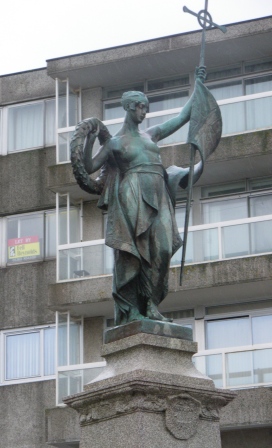Folkestone War Memorial facts for kids
The Folkestone War Memorial is a special monument located in The Leas area of Folkestone, Kent. It was officially revealed in 1922. This memorial remembers the 578 brave men from Folkestone who fought in the First World War. It also honors the many thousands of soldiers who passed through Folkestone Harbour during the war. Back then, Folkestone Harbour railway station was a very important place. Soldiers would leave from here to go to the battlefields in France via Boulogne. After the war, the road from the station to the harbour was even renamed the "Road of Remembrance" to remember these journeys.
Contents
Who Helped Create the Memorial?
A group of people worked together to create this memorial. The committee was led by Sir Stephen Penfold. He was a very important person in Folkestone, serving as the town's mayor twelve times between 1888 and 1918. This included four years in a row during the First World War (1914-1918). Sir Stephen was recognized for his help in welcoming refugees from Belgian when the war started. Sadly, his son, Jeffrey, was killed in 1916 during the Battle of Loos.
What Does the Memorial Look Like?
The memorial was designed by an artist named Ferdinand Victor Blundstone. It is about 7.6 meters (25 feet) tall and 7.9 meters (26 feet) wide. The main part is a bronze (metal) statue of a woman. She is said to represent "Motherhood" and "Reverence" (deep respect). The statue stands on a stone base that gets narrower towards the top. There are also stone walls on each side.
The woman in the statue holds a cross with a Union Flag banner in her left hand. In her right hand, she holds a laurel wreath, which is a symbol of victory and honor. She faces out towards the sea, looking across to France.
Messages and Names on the Memorial
The stone base of the memorial is made of Cornish granite. It has a special message written in gold letters: "MAY THEIR / DEEDS BE / HELD IN / REVERENCE." This means we should always remember their brave actions with respect.
There are also bronze plaques on the central base and the side walls. The main plaque shows a sculpture of soldiers marching forward. This reminds everyone of the many men who walked past this spot on their way to war. The plaque has a longer message that says: "THANKS BE TO GOD WHO GIVETH US THE VICTORY / IN EVER GRATEFUL MEMORY OF THE BRAVE MEN FROM FOLKESTONE, / AND THE MANY THOUSANDS FROM ALL PARTS OF THE EMPIRE WHO PASSED THIS SPOT ON THEIR WAY / TO FIGHT IN THE GREAT WAR (1914-1918) FOR RIGHTEOUSNESS AND FREEDOM, AND ESPECIALLY THOSE / OF THIS TOWN WHO MADE THE SUPREME SACRIFICE, AND WHOSE NAMES ARE HERE RECORDED, / THIS MEMORIAL IS HUMBLY DEDICATED." Other panels on the memorial list the names of those from Folkestone who died in both the First and Second World Wars.
Unveiling and Later Additions
The Folkestone War Memorial was officially revealed on December 2, 1922. Jacob Pleydell-Bouverie, 6th Earl of Radnor unveiled it, and the vicar of Folkestone, Peter Francis Tindall, dedicated it. A guard of honour (a group of soldiers showing respect) from the 1st battalion of the Oxfordshire and Buckinghamshire Light Infantry was present.
Many people laid flowers, including the Mayor of Folkestone and Colonel W J Dugan from Shorncliffe Army Camp. Representatives from France, Belgium, and Italy also laid flowers. After the Second World War, more plaques were added to remember those who died in that conflict.
Today, the memorial is surrounded by low railings and a wall. The gates of the railings also repeat the message: "MAY THEIR / DEEDS BE / HELD IN / REVERENCE." In June 2010, the memorial became a Grade II* listed building. This means it is a very important historical building that needs to be protected. It was also cleaned and repaired in 2018.
In 2014, a new memorial arch was added nearby. This arch was unveiled by Prince Harry.
Images for kids
-
The war memorial in Palmerston North, New Zealand, which looks similar to the one in Folkestone.





